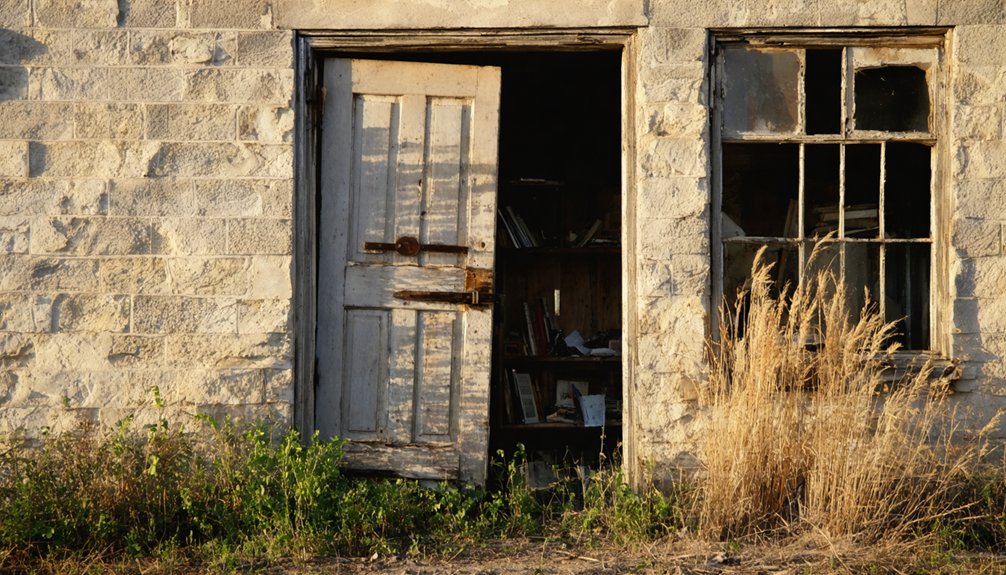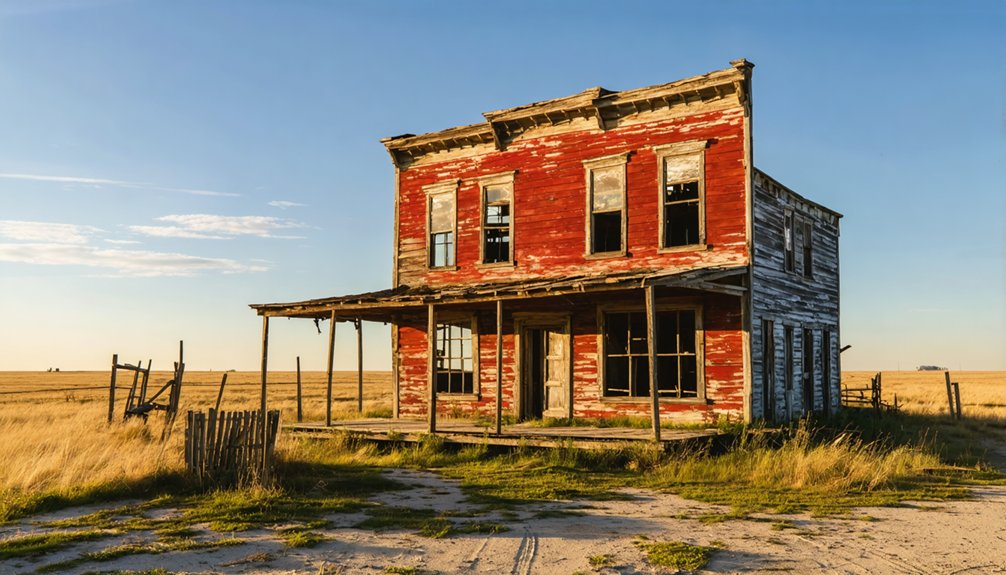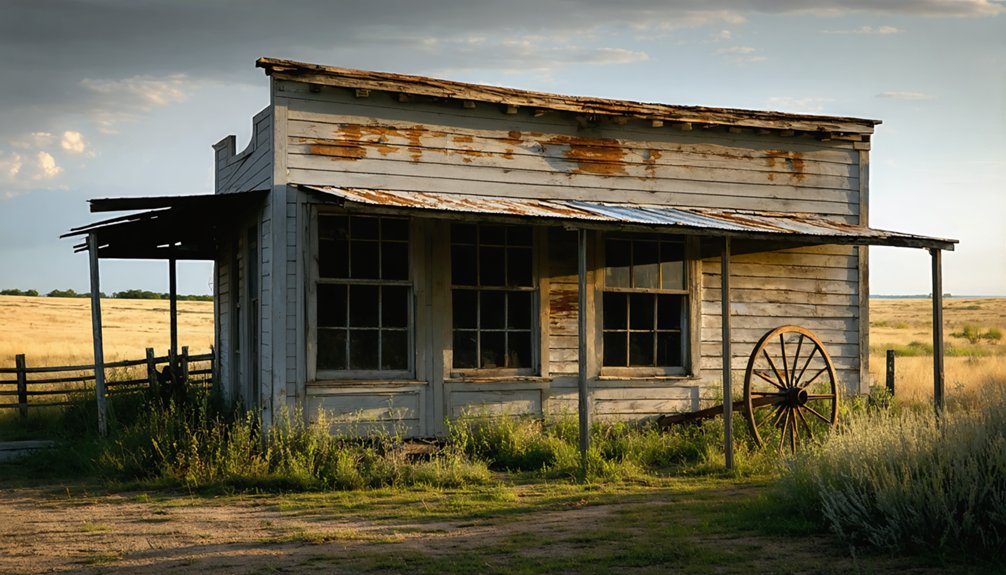You’ll find Sparta City’s remains in Lawrence County within South Dakota’s Black Hills region, where gold prospectors established this mining settlement in the 1870s. The town grew to over 1,000 residents after the Eagle Canal Company built the Sparta Ditch, employing Chinese laborers to solve critical water shortages. Today, you’ll encounter scattered mining remnants and deteriorated wooden structures across the landscape, though locating the exact site proves challenging. The untouched ruins hold countless stories of frontier life and mining innovation.
Key Takeaways
- Sparta City was a Black Hills mining settlement established during the gold rush, reaching a peak population of over 1,000 residents.
- The construction of Sparta Ditch in the early 1870s revolutionized mining operations, enabling more sophisticated gold extraction methods.
- Daily life centered around mining activities, with residents living in wooden cabins and gathering at the general store for social activities.
- The town’s decline began shortly after its founding, with residents departing for better opportunities elsewhere.
- Today, the site is difficult to locate and features scattered mining remnants, foundation stones, and archaeological artifacts from frontier life.
The Rise of a Black Hills Mining Settlement
When gold prospectors discovered rich placer deposits in the Black Hills region, they quickly established the settlement of Sparta, though initial mining efforts were hampered by insufficient water access.
You’ll find that everything changed in the early 1870s with the construction of the Sparta Ditch, a remarkable 32-mile water channel that transformed the settlement’s mining capabilities.
The Eagle Canal Company spearheaded this ambitious project, relying heavily on Chinese laborers who endured significant labor exploitation, often working up to 11 months without pay.
The cultural diversity of the workforce, including immigrant laborers and prospectors, shaped Sparta’s development as they built sophisticated engineering features like hand-dug tunnels and flumes along vertical rock walls.
This infrastructure boom marked Sparta’s emergence as a thriving mining hub, eventually leading to a peak population of over 1,000 residents.
Following the 1868 treaty with the Sioux Nation, the settlement’s presence represented a direct violation of Native American territorial rights.
Geographic Location and Natural Features
While prospectors and laborers toiled to build Sparta’s mining infrastructure, the settlement’s physical location played a key role in its development.
You’ll find Sparta City nestled in Lawrence County, South Dakota, amid the rolling topographical features that define the Black Hills region. The area’s ecological diversity reflects the broader landscape, where forests merge with expansive grasslands, creating a dynamic natural setting.
If you’re planning to explore this historic site, you’ll need to navigate carefully, as its exact location isn’t well-documented. Like the town of Witten, South Dakota, many of these remote settlements have dwindled to near ghost town status over the decades. Similar to how grain elevators remain as silent sentinels in towns like Cottonwood, the landscape bears witness to bygone prosperity.
The terrain surrounding the former settlement holds rich mineral deposits, particularly gold, which once drew enthusiastic miners to the area. Today, you’ll see the land primarily used for ranching, though remnants of past mining activities dot the landscape.
Water resources are scarce in the immediate vicinity, a factor that likely influenced the town’s development.
Mining Operations and Economic Foundations
Despite Sparta City’s promising gold-rich placer deposits, the settlement’s early mining operations faced significant water scarcity challenges until 1871.
That year, the Eagle Canal Company transformed the region’s mining prospects by constructing the 32-mile Sparta Ditch, largely built by Chinese laborers who endured harsh conditions and delayed wages. Similar labor challenges were faced at the Homestake Mine operations in Lead, which became the largest gold producer in the United States.
The mining techniques evolved from basic placer mining to more sophisticated operations. Early miners relied heavily on picks and shovels before advancing to more complex methods. You’ll find evidence of technological progress in the introduction of mercury amalgamation and later, cyanidization methods that boosted gold recovery rates to 94%.
The economic impact extended beyond gold, as coal mining emerged in the early 1900s. The Firesteel Coal Company became a significant employer, shipping up to 53,000 tons annually by 1942 and establishing vital railroad connections for ore transportation.
Daily Life in Sparta City’s Heyday
Throughout Sparta City’s peak years, you’d find a bustling frontier community where daily life revolved around the demanding rhythms of mining operations.
You’d start your day in a simple wooden cabin, heading out to face long hours of backbreaking work in the placer mines. After your shift, you might gather at the general store, where social gatherings naturally formed around card games and storytelling. Like many of the over six hundred ghost towns in the Black Hills, these gathering spots now lie in ruins.
Daily routines centered on survival and sustenance, with basic amenities like food and supplies arriving by wagon when weather permitted. In your modest home, you’d make do without modern plumbing or heating, sharing multipurpose living spaces with family or fellow workers. Similar to the Gaslight Restaurant in Rockerville, the local saloon served as a primary social hub.
The community pulled together through local trading, shared meals, and informal events that helped ease the harsh realities of frontier life.
Notable Buildings and Infrastructure
You’ll find remnants of Sparta City’s mining operations scattered across the landscape, including weathered ore processing equipment and the skeletal frames of what were once bustling mining structures.
Like many ghost town sites, the area shows various states of disrepair and abandonment across the property.
The town’s transportation network featured well-worn wagon trails connecting to nearby settlements, though these paths are now barely visible through overgrown vegetation.
Similar to the restored buildings from historic prairie towns, many structures were transported here from distant locations.
The miners’ quarters, consisting of simple wooden cabins and communal bunkhouses, stand in various states of decay along what was once the main residential area.
Mining Structures and Equipment
The industrial backbone of Sparta City lay in its extensive mining infrastructure, anchored by underground shafts and sophisticated ore processing facilities.
You’ll find remnants of wooden headframes that once powered the ore extraction methods, while elevated tramways connected mines to processing mills across the rugged terrain. The site’s mining technology advancements included reduction mills similar to the nearby Mystic Mill, which pioneered electrolysis techniques for metal extraction.
Water management proved essential to Sparta’s operations, with the impressive 32-mile Sparta Ditch system supporting both placer and hard rock mining.
The infrastructure included cyanide process vats, ore bins, and tailings ponds, while worker facilities encompassed bunkhouses, assay labs, and company offices – though most have since been dismantled or relocated.
Transportation and Access Routes
Located in South Dakota’s Black Hills region, Sparta City’s transportation network centers on unpaved county roads branching from State Highway 34.
You’ll face transportation challenges managing the sparse signage and deteriorating dirt tracks, especially during winter snows and spring rains when four-wheel drive becomes essential.
While the town’s original grid pattern streets are barely visible today, you can still find remnants of its transportation past.
A weathered freight storage shed, depot platform foundation, and blacksmith shop ruins hint at the once-bustling mining community.
The dismantled railroad infrastructure, vital for hauling ore and supplies during Sparta City’s heyday, has given way to hiking trails.
Access difficulties increase with erosion and minimal road maintenance, leaving potholes and washouts that underscore the ghost town’s abandoned status.
Living Quarters Remains
While exploring Sparta City’s residential remnants, you’ll encounter scattered foundation stones and weathered timber frames that outline where miners and their families once lived.
The abandoned homes, built primarily of local timber with simple rectangular layouts, reflect the harsh living conditions of frontier life. Near these residential ruins, you’ll find traces of wellhouses and auxiliary structures that once supported daily life in this Black Hills settlement.
- Stone foundations peek through prairie grass, whispering stories of families who carved out lives in this unforgiving landscape
- Roofless wooden structures stand as silent sentinels, their weathered boards bearing witness to decades of isolation
- Remnants of old wells and cisterns mark gathering spots where neighbors once shared news and water during Sparta City’s heyday
The Decline and Abandonment

Despite its early promise as the Buchanan County seat, Sparta City’s decline began almost immediately after its 1840 founding due to an inability to attract substantial population or commerce.
The settlement never expanded beyond a few basic stores, leading to economic stagnation that proved insurmountable. You’ll find that the town’s struggles were compounded by fierce competition from neighboring communities that drew away potential residents and investments.
Population migration accelerated as residents sought better opportunities elsewhere, and by 1878, the town was effectively abandoned.
Without maintenance, the remaining structures succumbed to South Dakota’s harsh weather and time. Agricultural challenges, limited transportation connections, and geographic isolation sealed Sparta City’s fate.
Today, you won’t find any significant remains or tourism development at the former townsite.
Archaeological Discoveries and Remnants
Archaeological investigations at the former Sparta City site have yielded significant insights into both prehistoric and historic human activity in the region. You’ll find evidence spanning from ancient Paleoindian times through the town’s abandonment, revealing the archaeological significance of this location.
The site contains collapsed brick chimneys, fragments of dishware, and gaming pieces that paint a picture of daily cultural practices. Local stone materials like porcellanite and Knife River flint show how residents adapted to available resources.
- Stand where ancient hunters once crafted tools from Black Hills quartz and watch your connection to the past come alive
- Discover the stories hidden in privy deposits, where personal items tell tales of frontier life
- Walk among the remnants of cooking areas where families once gathered, sharing meals and building community
Historical Significance in South Dakota

As one of South Dakota’s lesser-known ghost towns, Sparta City emerged during the Black Hills gold rush of 1878, marking a significant chapter in the state’s mining heritage.
You’ll find its story deeply woven into the cultural heritage of the region, where mining camps transformed into bustling communities almost overnight.
Like many of its contemporaries, Sparta City reflects the boom-and-bust cycle that shaped South Dakota’s community identity.
The ephemeral nature of Sparta City echoes through South Dakota’s history, marking an era when fortunes rose and communities crumbled.
While it didn’t achieve the fame of larger mining settlements, it contributed to the state’s pioneering spirit and economic development.
The town’s rise and fall mirrors the broader historical pattern of the Black Hills region, where harsh winters, remote locations, and declining mining opportunities led to the abandonment of numerous settlements, leaving behind a record of South Dakota’s rugged frontier past.
Visiting the Ghost Town Today
While locating Sparta City today presents significant challenges, even experienced ghost town enthusiasts will find the site’s exact whereabouts difficult to pinpoint in Lawrence County.
Your ghost town exploration will reveal a barren landscape where nature has reclaimed most traces of the former settlement. You’ll need to prepare thoroughly, as there’s no historical preservation infrastructure or marked pathways to guide your visit.
- Feel the raw authenticity of untouched history as you navigate the unmarked terrain where pioneers once built their dreams
- Experience the profound solitude of a truly forgotten place, far from modern amenities and tourist facilities
- Connect with South Dakota’s past as you search for subtle clues and scattered remnants in the overgrown landscape
Remember to bring GPS equipment, research maps carefully, and check with local historical societies before attempting to locate the site.
Frequently Asked Questions
What Natural Disasters or Epidemics Affected Sparta City During Its Existence?
Like a raging river through time, you’d have witnessed devastating flood damage along Rapid Creek near Sparta City, though there’s no specific documentation of disease outbreaks directly affecting the settlement.
Were There Any Famous Outlaws or Notable Crimes Associated With Sparta?
You won’t find any notable outlaws or infamous crimes tied to this settlement. Historical records don’t mention significant criminal activity, unlike nearby Black Hills towns that had their share of lawlessness.
Did Native American Tribes Have Settlements or Interactions Near Sparta City?
You’ll find the Dakota Sioux, especially Yankton and Yanktonai bands, had extensive tribal interactions near this area before European settlement. Their traditional territories included lands surrounding what later became Sparta City.
What Happened to the Cemetery and Burial Grounds of Sparta City?
Like Google Maps can’t find it today, you’ll see a hilltop cemetery with poor preservation, where ground radar revealed 389 burials but most burial records vanished. Many markers eroded, leaving identities unknown.
Did Any Major Historical Figures or Celebrities Ever Visit Sparta City?
You won’t find evidence of any famous visitors to this place. Despite its historical significance as an early county seat, records don’t indicate any celebrities or major figures ever visited here.
References
- https://www.sdpb.org/rural-life-and-history/2023-08-21/some-black-hills-ghost-towns-and-their-origins
- https://www.sdhspress.com/journal/south-dakota-history-2-2/some-black-hills-ghost-towns-and-their-origins/vol-02-no-2-some-black-hills-ghost-towns-and-their-origins.pdf
- https://westernmininghistory.com/towns/oregon/sparta/
- https://www.powderhouselodge.com/black-hills-attractions/fun-attractions/ghost-towns-of-western-south-dakota/
- https://www.youtube.com/watch?v=_0WNYsFLSLA
- https://www.youtube.com/watch?v=A3nKg9HX6FE
- https://en.wikipedia.org/wiki/List_of_ghost_towns_in_South_Dakota
- https://aberdeenmag.com/2019/01/the-ghost-towns-of-brown-county/
- https://www.ghosttowns.com/states/mo/sparta.html
- https://history.sd.gov/museum/docs/Mining.pdf



